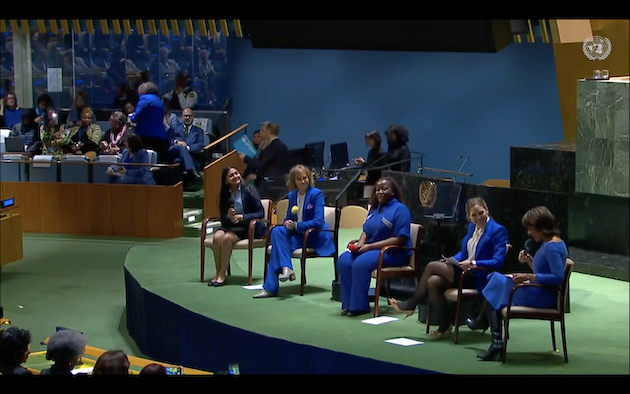Gender-Responsive Approach to Technology and Innovation Will Ensure Progress — Global Issues
UNITED NATIONS, Mar 10 (IPS) – Promoting gender equality in technology and digital spaces is at the core of the UN’s observance of International Women’s Day (IWD) as UN senior officials call on the world to take concrete action against ingrained gender biases.
The United Nations and UN Women hosted their observance of IWD under the theme “DigitALL: Innovation and technology for gender equality,” with a special celebration of women and girls in the STEM fields. This year’s theme aligns with digital transformation and innovation for educating women and girls currently being discussed at the 67th Commission of the Status of Women (CSW).
The event was hosted by journalist and WABC-TV anchor Sabe Baderinwa, who remarked on the theme’s significance by reminding attendees that “access to and control over technology is crucial for women’s economic and social empowerment.”
The event touched on the significance of promoting gender equality in the digital space through the meaningful ways technology and innovation can empower women and girls when given the opportunity. It also notably dissected the barriers preventing complete gender parity in this sector. Put simply, women and girls have historically been underrepresented in the STEM fields and are prevented from unlocking the full potential of technology.
At present, nearly 37 percent of women do not have access to the internet, meaning that they neither have access to resources nor are able to acquire useful digital skills. Those women and girls who do use technology and occupy digital spaces are at greater risk of being subject to online harassment and violence, and misogynistic attitudes.
The gender disparity in online spaces is also evident in the ways that online harassment has targeted women and girls in these spaces and has even pushed them off these platforms. Within the tech industry, women make up less than a third of the workforce, with even fewer of them in leadership positions.
This was pointed out by several of the speakers present at the event, including President of the General Assembly Csaba K?rösi in his opening remarks.
“As it stands, far too many women and girls still cannot access the opportunities offered by technology… Women are twenty-seven times more likely than men to face online harassment and hate speech. Only one in four reports , and nearly nine in ten limit their online activity because of it, reinforcing the digital divide.”
Secretary-General Antonio Guterres said in a statement that technology can lift women and girls up in “a myriad of ways” through access to education and healthcare or entrepreneurship. But the full promise of technology can only be realized when the systematic barriers have been confronted. This starts with including more women in leadership roles in the tech sector.
“Without women’s leadership, the Silicon Valleys of this world don’t disrupt the patriarchy; they simply digitize sexism and perpetuate inequalities. And without women’s leadership, tomorrow’s products will have gender equality built into their code.”
In his own statement at the event, the Secretary-General’s Chef de Cabinet Earle Courtney Rattray brought attention to how the disparity in technology access is more prominent in developing countries, including the Least Developed Countries.
“Nowhere is this more evident than in LDCs,” he said. “According to the International Telecommunications Union, about two-thirds of the LDC population remains offline, and the gap between these countries and the rest of the world in the of people losing access to the internet has increased from 27% in 2011 to 30% last year.”
“The inclusion of women and girls as prominent key players in digital evolution for current and future generations gives the opportunity to address the most critical development and humanitarian challenges,” Chair of the 67th Commission on the Status of Women Mathu Joyini said in her statement.
UN-Women Executive Director Sima Bahous reminded those in attendance of the Sustainable Development Goals (SDG), particularly SDG5, which calls for gender equality and the empowerment of all women and girls. “It is no coincidence that today, as SDG5 is off-track, so are the SDGs as a whole. We live in a world of interconnected crises. At the heart of every crisis, we see inequality multiplied. We now have a new form of poverty. Digital poverty is growing and intensely gendered.”
In her statement, Secretary-General of the International Telecommunications Union (ITU) Doreen Bogdan-Martin shared stories of young women and girls who used technology to improve the quality of life in their communities through their own innovations, remarking on how their examples “reminds us that technology is not a luxury, but a necessity.”
“We have the foundation because all countries agree on the need to achieve universal connectivity, and they agree on the need for sustainable digital transformation,” she said. “We also have the momentum, the Partner2Connect Digital Coalition led by the ITU, together with many UN partners, has mobilized in one year over $17 billion USD for digital gender equality. We also have the unique opportunity… all of us today together, to ensure that gender equality happens in our lifetime and not in 300 years.”
During a panel discussion moderated by Baderinwa, the current state of technology and innovation was further explored, with particular attention paid to the involvement that would be needed from multiple stakeholders to achieve gender parity.
As journalist and UN Women Goodwill Ambassador Marion Reimers remarked, when it comes to the safety of women and girls, attention should be given to the systems that perpetuate harassment online, including in the case of women journalists.
“We are so far behind because it feels like there is no help because this is a new landscape, and it has created so many new necessities that we need to catch up real quick,” she said. “When you take into account that 75% of women journalists are victims of online harassment, this is directly intertwined with how we speak about problems in the public sphere… with how the voices of women are taken into account.”
“If we want to succeed, we must have meaningful participation and involvement from civil society,” said Marie Bjerre, Minister for Digital Government and Gender Equality in Denmark. She also added that governments’ involvement should include introducing legislation that would place more protections online, citing Denmark’s own examples in passing laws that target online grooming and the distribution of intimate images.
Director of Strategic Initiatives at Pollicy, Dr Irene Mwendwa, spoke from the perspective of policymakers and researchers in the field and the transformative power that technology can have for local government women leaders in Africa. “Once they understand the power of technology and data, when they go into the council, when they go into cabinet and parliament, they will be able to debate better. When they debate better over the legal frameworks, the policies coming out of our countries into our communities will be inclusive to both women’s and men’s needs, pertaining to ICT.”
Finally, the perspective and contributions of young people as those most involved and present in online spaces must also be encouraged, especially young women. UNICEF Youth Advocate Gitanjali Rao remarked on the opportunity to “harness the ingenuity that youth bring to the plate.”
“Now is the time to maximize creativity. We should be taking these opportunities to look at the ways in which we can support girls, especially by digitizing content online and honestly supporting them in every way possible, whether that’s through the work they’re doing or making sure that they’re safe online as well,” she said.
The speakers and panelists called for multiple measures to be taken that could address the systemic gaps and inequalities that women and girls face with technology. These measures include broadening access to technology to reach more people, investing in digital skills-based learning for women and girls to effectively make use of technology and learning, and breaking down the gender biases and binaries that make digital spaces unsafe for certain groups, especially through gender-based violence facilitated through technology.
This also means promoting more women into leadership and decision-making roles in the tech sector and beyond, where there are able to directly influence policy and legislation. As technology continues to be ubiquitous in our daily lives, a gender-responsive approach will be crucial to future innovations.
“Without decisive action, the digital gender divide will become the new face of widening social and economic inequalities,” Deputy Secretary-General Amina Mohammed said in a video statement at the end of the event.
IPS UN Bureau Report
© Inter Press Service (2023) — All Rights ReservedOriginal source: Inter Press Service
Check out our Latest News and Follow us at Facebook
Original Source







